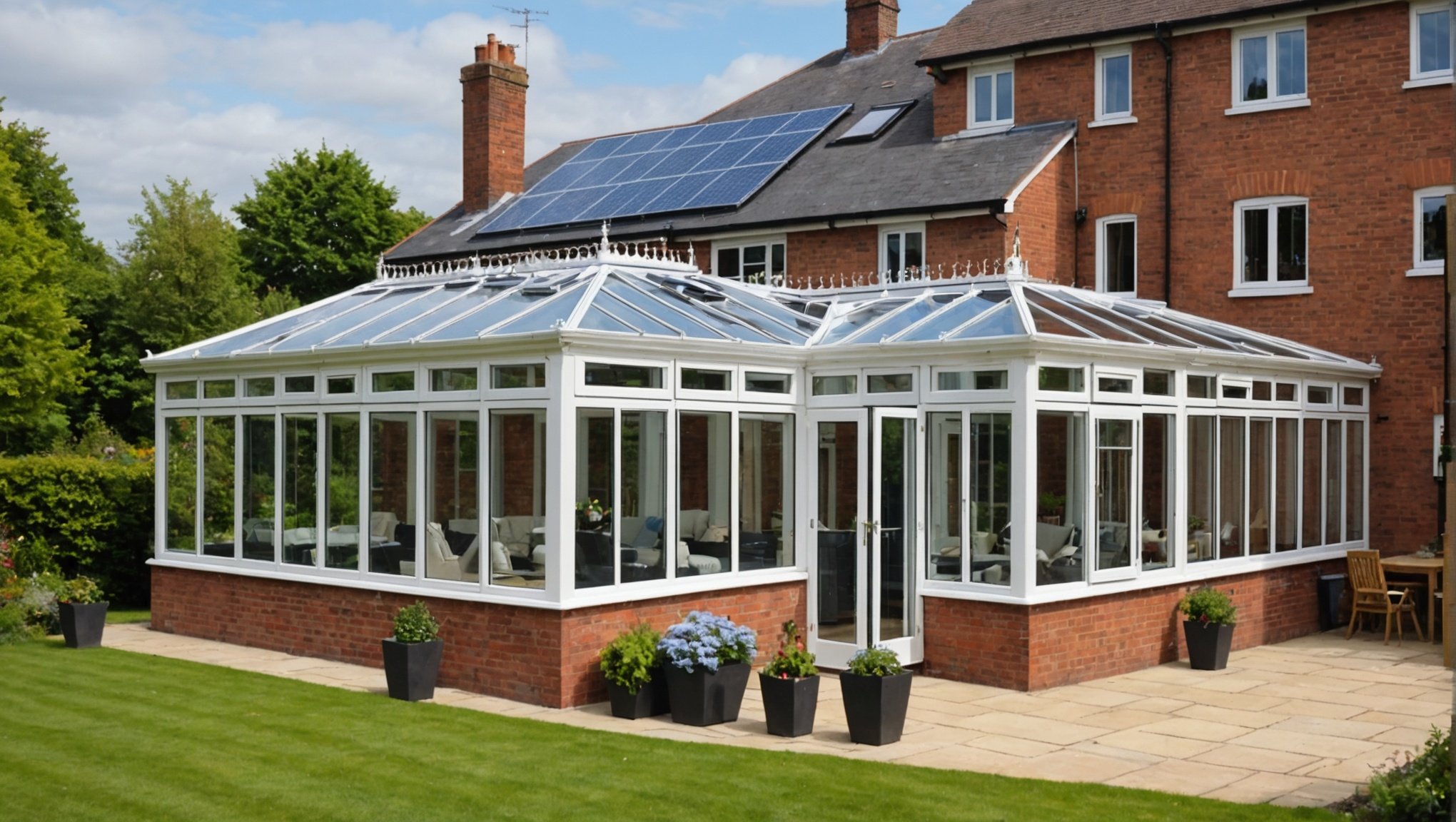Choosing the right conservatory for your UK heritage home is essential to enhance its charm and maintain architectural integrity. Balancing aesthetics with functionality can be challenging, but this guide simplifies the process. Explore styles that complement historical features, materials that withstand the British climate, and design elements that enhance your living space. Discover how to create a seamless transition between indoor and outdoor areas while respecting your home's character. Embrace the opportunity to elevate your property with a thoughtful conservatory choice.
Understanding Heritage Home Architecture
Heritage homes in the UK are a testament to the country's rich architectural history, showcasing a variety of heritage home styles. These styles often reflect the era in which they were built, with common examples including Georgian, Victorian, and Edwardian architectures. Each style possesses distinct architectural features that contribute to its unique charm and historical significance.
A découvrir également : Crafting Comfort: The Ultimate Guide to Choosing and Styling Cushions for a Chic UK Living Room
Georgian homes, for instance, are characterized by their symmetry and classic proportions, often featuring sash windows and decorative mouldings. In contrast, Victorian homes are known for their ornate detailing, including intricate brickwork and stained glass. Edwardian properties, meanwhile, often incorporate elements like timber frames and large bay windows, providing a more open and airy feel.
Understanding these architectural features is crucial, especially when considering renovations or restorations. The UK has stringent conservation guidelines that aim to preserve the authenticity and integrity of heritage homes. These guidelines dictate what changes can be made to a property, ensuring that any alterations respect the original design and materials.
A lire aussi : Discover Top Eco-Conscious Furniture Choices for Your UK Living Room Makeover
Adhering to these guidelines not only protects the historical value of the property but also maintains its aesthetic appeal. For homeowners, this means that any renovation project must be carefully planned and executed, keeping the heritage home styles and architectural features in mind.
Legal Regulations for Conservatories
Navigating the legal regulations for conservatories in heritage homes can be complex, but understanding the requirements is essential. When planning to add a conservatory, planning permission is often required. This ensures that the proposed structure aligns with local development plans and does not negatively impact the surrounding area. Generally, if a conservatory exceeds certain size limits or is in a designated area, such as a conservation area, planning permission becomes necessary.
In addition to planning permission, compliance with building regulations is crucial. These regulations focus on the structural safety, energy efficiency, and accessibility of the conservatory. Key considerations include ensuring adequate ventilation, proper insulation, and safe electrical installations. Adhering to these regulations guarantees the conservatory is both safe and functional.
For listed buildings, obtaining listed building consent is mandatory. This consent protects the architectural and historical significance of the property. It involves a detailed review of the proposed changes, ensuring they respect the original character and materials of the building. Applications for listed building consent must be thorough, often requiring detailed plans and justifications for the proposed work. Following these guidelines helps preserve the integrity of heritage homes while allowing for modern adaptations.
Design Styles for Heritage-Compatible Conservatories
Creating a conservatory that complements a heritage home requires careful consideration of design ideas that maintain architectural harmony. Popular design styles often incorporate period features that resonate with the existing structure. For instance, a Victorian-style conservatory might feature ornate detailing and stained glass, echoing the intricate brickwork and decorative elements typical of Victorian architecture.
When designing a conservatory for a Georgian home, symmetry and classic proportions are key. This might involve the use of sash windows and decorative mouldings, ensuring that the new addition does not disrupt the visual appeal of the property. For Edwardian homes, incorporating timber frames and large bay windows can provide a seamless transition between the old and new, enhancing the property's open and airy feel.
Architectural harmony is crucial in maintaining the aesthetic and historical value of heritage homes. By integrating period features such as traditional materials and design motifs, homeowners can ensure their conservatory adds to the overall charm without overshadowing the original structure. Ultimately, achieving visual appeal in a heritage-compatible conservatory involves a delicate balance between respecting the past and embracing modern functionality.
Materials for Heritage Conservatories
Selecting the right conservation materials for a heritage conservatory is crucial for maintaining architectural integrity. Recommended materials often include traditional materials like timber, wrought iron, and natural stone. These materials not only resonate with the historical aesthetics of heritage homes but also ensure structural compatibility with existing features.
Sustainability is another vital consideration when choosing materials. Opting for sustainable options, such as reclaimed wood or recycled metal, can significantly reduce environmental impact. These choices contribute to the longevity and energy efficiency of the conservatory, aligning with modern environmental standards while preserving historical charm.
Incorporating traditional and sustainable materials offers numerous benefits. For instance, timber provides excellent insulation, while wrought iron offers durability and strength. Natural stone, with its timeless appeal, enhances the conservatory's visual harmony with the main structure.
Case studies highlight successful applications of these materials. For example, a Victorian home in Bath used reclaimed timber and wrought iron to create a conservatory that seamlessly blends with the original architecture. Such examples underscore the importance of thoughtful material selection, ensuring that new additions complement the historical essence of heritage properties.
Practical Tips for Choosing a Conservatory
When selecting a conservatory, understanding the various conservatory types is essential. Options range from traditional styles like Victorian and Edwardian to modern lean-to designs. Each type offers unique benefits, such as the functionality of lean-tos, which fit well in limited spaces, or the grandeur of Victorian styles with their expansive views.
Site assessment is crucial in determining the most suitable conservatory type for your property. Begin by evaluating the available space, considering factors like orientation to the sun, which affects natural light and temperature. Assess the landscape and existing structures to ensure seamless integration with your heritage home.
To maximise functionality and comfort, consider insulation and ventilation. Proper insulation materials and double-glazed windows can help maintain a comfortable temperature year-round, while adequate ventilation prevents moisture build-up. Additionally, selecting quality flooring materials, such as tiles or hardwood, enhances both comfort and durability.
Incorporating these practical tips ensures your conservatory not only complements your heritage home's architecture but also serves as a functional and comfortable living space. By carefully considering conservatory types and conducting a thorough site assessment, you can make informed decisions that enhance your property's value and appeal.
Maintenance Considerations for Conservatories
Proper conservatory upkeep is key to preserving its beauty and functionality over time. Regular maintenance not only ensures the longevity of your conservatory but also protects your investment. Essential maintenance tips include cleaning the glass and frames to prevent the build-up of dirt and debris, which can cause damage over time. Inspect seals and joints for any signs of wear, as these are critical for maintaining insulation and preventing leaks.
To further ensure longevity, check the conservatory roof for any damage or obstructions that might lead to water ingress. Regularly lubricate moving parts like hinges and locks to keep them operating smoothly. This simple upkeep can significantly extend the lifespan of your conservatory.
Seasonal care is also crucial. In winter, ensure that gutters and drainage systems are clear of leaves and debris to prevent water damage. During summer, consider shading solutions to protect against excessive heat and UV damage.
By incorporating these maintenance practices, you can enjoy a well-maintained conservatory that remains a valuable and attractive part of your home. Remember, consistent care not only enhances durability but also keeps your conservatory looking its best throughout the year.
Cost Factors of Conservatories
When considering a conservatory, understanding the conservatory costs is crucial for effective financial planning. The cost of building a conservatory can vary significantly based on several factors. These include the size and design of the conservatory, the materials used, and the complexity of the installation process. Additional features, such as heating and ventilation systems, can also impact the overall cost.
To manage these expenses, homeowners should focus on budgeting effectively. Begin by obtaining multiple quotes from reputable contractors to gauge a realistic price range. Consider prioritising essential features over optional extras to keep costs manageable. It's also wise to include a contingency fund to cover unexpected expenses.
Financial planning is a key component in making your conservatory dream a reality. Explore various funding options, such as home improvement loans or remortgaging, to spread the cost over time. Some homeowners may also qualify for grants, particularly if the conservatory enhances energy efficiency.
By carefully considering these factors, you can ensure that your conservatory project aligns with your financial capabilities, allowing you to enjoy a beautiful and functional addition to your home without undue financial strain.
Expert Recommendations and Case Studies
Gaining insights from professionals in conservatory design and construction can significantly enhance the success of your project. Experts recommend prioritising architectural harmony and material compatibility to ensure a seamless integration with heritage homes. For instance, using traditional materials like timber and wrought iron not only respects the historical essence but also ensures durability.
Real-life case studies provide valuable lessons. One notable example involves a Georgian home in Surrey, where a conservatory was designed with classic proportions and sash windows. This project exemplifies how professional advice can lead to a harmonious blend of old and new, enhancing the property's overall appeal.
Homeowners often share success stories that highlight the importance of thorough planning and expert guidance. For example, a Victorian home in York successfully incorporated stained glass in its conservatory, maintaining architectural integrity while adding a modern touch. These experiences underscore the value of consulting with professionals who understand heritage architecture.
Key lessons from these projects include the importance of detailed planning, respecting conservation guidelines, and selecting experienced contractors. By learning from these real-life examples, you can make informed decisions, ensuring your conservatory complements your heritage home beautifully.
















